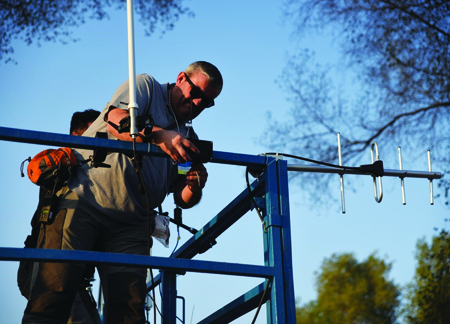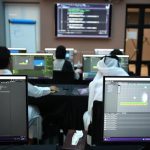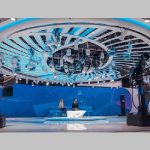Qatar National Day on December 18 called for special broadcast skills and, in particular, RF solutions to cover the event live. BroadcastPro ME brings you an exclusive report on how RF specialist Sobatech worked with DTC to make this coverage spectacular, as per the mandate of Qatars State National Day Celebrations Organising Committee Qatar National […]
 Qatar National Day on December 18 called for special broadcast skills and, in particular, RF solutions to cover the event live. BroadcastPro ME brings you an exclusive report on how RF specialist Sobatech worked with DTC to make this coverage spectacular, as per the mandate of Qatars State National Day Celebrations Organising Committee
Qatar National Day on December 18 called for special broadcast skills and, in particular, RF solutions to cover the event live. BroadcastPro ME brings you an exclusive report on how RF specialist Sobatech worked with DTC to make this coverage spectacular, as per the mandate of Qatars State National Day Celebrations Organising Committee
Qatar National Day (QND) is celebrated throughout the country every 18 December as a spectacular national commemoration of the day in 1878 when Sheikh Jassem bin Mohamed bin Thani succeeded his father as the ruler of Qatar and unified the country, thus establishing Qatar’s independence. It is a public holiday, full of traditional food festivals, a centrepiece parade, multiple air shows and entertainment throughout the day and night, culminating in a beautiful fireworks display. Hundreds of thousands turn out each year to share their pride and loyalty to their homeland.
The State National Day Celebrations Organising Committee (SNDCOC) was the host broadcaster for the televised coverage of the celebration, and produced the live programme centred on Doha, which was aired by all Qatar national broadcasters. The content was also free to access for all GCC broadcasters, including Al Jazeera, Qatar TV,
Al Rayyan Satellite Channel, Al Kass (who provided the OB van) and numerous other broadcasters in the region.
With the occasion calling for big action, a comprehensive and challenging RF set-up was required to cover the main celebrations at Dohas West Bay. The SNDCOC called again on Sobatech Group, a Spanish production services, technical consultancy and RF systems provider, to realise their ambitions.
This is the second consecutive year that we were awarded the contract for technical direction of the live broadcast, says Xavier Soler, Sobatech Managing Director and Television Production Technical Director and Consultant for SNDCOC.
SNDCOCs plans for the celebration and broadcast this year were quite extensive. The challenge for us was to successfully execute the large number of proposals that came down from the production department. They really wanted amazing shots for their live feed, which required the largest RF deployment weve ever done, including 15 members of our own specialised, highly experienced staff.
For an event like this with a large amount of RF links in the middle of a busy city like Doha, all frequencies, the antenna type and location, the filters, as well as the power used in the transmitters, are really important.
For the QND project, Sobatech Group used Domo Tactical Communications (DTC) Ltd (formerly Cobham TCS), RF transmit and receive technology from its own inventory, and Domo kit hired from UK-based Broadcast RF.
The range included Domos SOLO ENG, SOLO4 and SOLO7 HD Nano transmitters, as well as SOLO7 NanoVue HD and PRORXB receivers. Sobatech also deployed its own Domo PRORXD, which formed the heart of a ten-channel, 8/4-way reception network that combined DVB-T and Domo ultra-mobile video link (UMVL) modulation.
The RF setup comprised one network of eight 12 dBi antennas, extended via an optical fibre system designed by SBNlab, a Sobatech solution, which covered the 10 square kilometres of the paved Corniche Road area serving as the focal point of the parade and celebrations.
A separate network of four 12 dBi antennas, also extended via an SBNlab-designed fibre optical system, covered 50 cubic kilometres of sea and airspace in the Corniche Road area.
A single ASI relay system with a Domo SOLO7 Nano HD transmitter and 10dB amplifier delivering a total output of 27dBm was installed eight kilometres from the central TV compound to focus on the airspace, with reception working at UMVL modulation to enhance its performance for high-speed operation, and two 12 dBi antennas, a 12dBi antenna and two Omni 4.5dBi antennas linked to one UMVL-enabled PRORXB four-way receiver.
A total of eight eight-way receivers were deployed six for the Corniche Road network and two that combined road, sea and air. A second network was established with two PRORXB four-way diversity receivers and the PRORXD diversity receiver provided by Sobatech Group.
For ground-based transmitters, a Domo SOLO ENG transmitter with 3dBI S-Band flexi-antenna was mounted on each of two Segway-mounted Steadicams. One handheld camera was fitted with a SOLO4 and 3dBI S-Band flexi-antenna, and a studio configuration camera six kilometres from the TV compound was equipped with another SOLO ENG, this time with a 27dBm SOLO ENG Transmitter and 9dBi sector antenna.
UK-based RF specialist VideoSys provided the telemetry system, providing full colour control to a camera six kilometres from the TV compound, as well as for the Steadicam and a variety of handheld cameras.
Six PoV cameras were deployed for aerial work, in this case with telemetry systems designed by Bradley Engineering that were further customised by SBNlab. Two parachutists from the Qatar National Parachute Team, who participated in a sky-diving performance that included airborne feats described as one excitement after another, were supplied with SOLO7 Nano HD transmitter-equipped PoV cameras, one with a 3dBi blade antenna and the other with a 2dBi linear antenna.
The shots we obtained were spectacular and, importantly, uninterrupted, which provided highly appealing options for the television production, explains Soler.
But our next aerial aerobatics challenge was much higher and much faster.
Another PoV camera with a SOLO7 Nano HD transmitter was mounted in the cockpit of an advanced Pilatus PC-21 aircraft for coverage of the aerobatic display teams performance over the bay. This was the first time a live camera and video link had been installed inside an aircraft for Qatar National Day. In previous years, the shots from aircraft were pre-recorded.
Typically, when RF equipment is installed far from a television compound, such as in an aircraft, a technical team just has to rig it up and hope for the best, as there is no practical way to test it properly. For the high-speed aircraft shots, however, Sobatech needed more certainty and decided to use Domos new NanoVue HD receiver and display device.
We were careful to do complete field testing on the technology before the event, particularly for use with the aircraft to ensure that the transmit and receive system could compensate for high speeds and potential issues with the Doppler effect, says Soler.
Using NanoVue HD, we were able to check the RF systems for the aircraft and the parachutists before their flights and found that the RF system worked perfectly, which meant that we were able to take HD feeds straight into production. I believe this equipment is mandatory for such productions, the team claims.
The coverage of the day included shots never before achievable for Qatar National Day.
Events of this scale test the performance of RF systems to their very limits, Solar points out.
Domo transmit and receive systems enabled us to go wherever we needed to go to get a shot, and this year we needed to go further than wed ever been, to cover more than we ever had.















































































